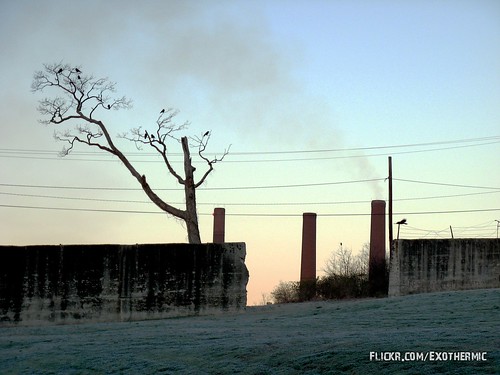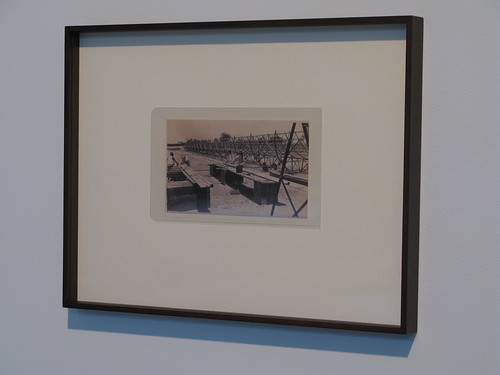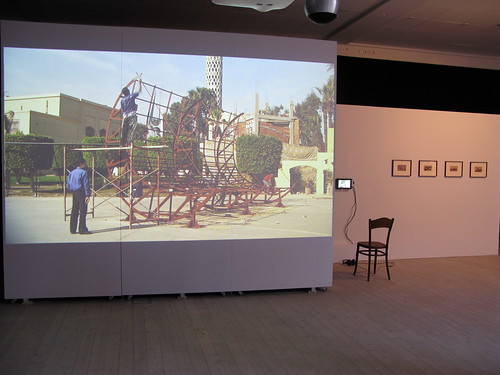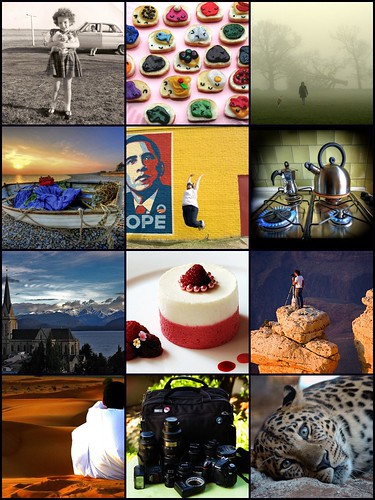1290 Avenue of the Americas (formerly Coconuts record store); site of the historic 1994 meeting between Mariah Carey and yours truly
Image by InSapphoWeTrust
I am at the intersection of West 51st Street and Avenue of the Americas (Sixth Avenue), northeast corner. Sure, the red decor of the Sovereign Bank branch is interesting, but that's not why I took this photo.
Back in the 1990s, when I was based in New York City, this was a location of Coconuts. And on 21 November 1994, Mariah Carey was here to do a meet-and-greet to sign her then-new Christmas release, Merry Christmas. A key single from that album, "All I Want for Christmas Is You," went on to become the most popular Christmas song ever.
On that day, I was right here. The bank lobby to the right was the store entrance, and the ATM lobby to the left was where Mariah would have sat at a desk to meet with the fans. Just outside the ATM lobby on the sidewalk was where the line was - circling the entire block. After a 12-hour wait, I managed to say hello, and have a chat. (The meet-and-greet ran only two hours, 5PM to 7PM. I had arrived at dawn to line up.)
This event marked my first-ever meeting with my favorite celebrity. I would not have another celebrity meeting until 2006. And even today, this remains one of my favorite spots in New York City, thanks to all the 1994 memories still staying fresh.
As one of the few idols of my earlier years, Mariah Carey holds a special place in my heart. And with the passing of my other early idols - Michael Jackson in 2009, Whitney Houston in 2012 - Mariah Carey is also the last early idol of mine who is still alive.
TN State Prison 010
Image by Exothermic
The Ford Glass Plant in the distance.
This photo was feature at the Hibbleton Gallery in California.
Built at the close of the 19th century, the Tennessee State Prison housed inmates until it was closed in 1989. From the time it began operations in 1898, the 800 cells of the prison had almost continually been over crowded. Throughout it's history numerous calamities have occurred at the penitentiary including riots, mass escapes, and fires. Conditions at the facility were forbidding and harsh due to overcrowding, sanitation problems and insufficient ventilation. In 1983 a federal court decision prohibited the Tennessee Department of Corrections from ever housing prisoners at the TN State Prison.
Since 1992 the facility has been left mostly abandoned. Several buildings on the massive compound are still in some use today, but the rest of the prison lies in disrepair and deterioration. The Tennessee State Prison is now a wonderland of decay. Not without danger, the buildings on the site are contaminated with black mold, asbestos, and lead based paint among other obvious perils. Yet, it is a completely fascinating location to explore. Numerous films and music videos have been shot on the grounds of the prison.
Nearly all of my exploration of this site on this visit was of the medical facility on the northern end of the compound. The medical facility one of the most restricted buildings at the prison, attributable in part to damage caused by a film crew from VH1 that were visiting to shoot the “Celebrity Paranormal Project.”
References
Historic Decay
Abandoned Online
(detail) Nº1 SUN ENGINE (2008–9)
Image by latitudes-flickr
Nº1 SUN ENGINE (2008–9)
Video projection and LCD monitor (20 min.) with headphones. Four framed photographs from 1913.
In 1913, Philadelphia inventor and businessman Frank Shuman (1862–1918) inaugurated the world’s first commercial-scale solar thermal generator in Maadi, near Cairo, Egypt. With the backing of the British colonial powers, who were keen to strengthen the Empire’s control over the country by upgrading its irrigation infrastructure, Shuman built the plant from scratch using local materials. He developed a system which used five 60 metre-long parabolic mirrors and a mechanism which kept them at the most efficient angle to reflect the sun onto water-filled boxes, creating low-pressure steam which drove turbines. The resultant energy was used to power an engine capable of pumping over 20,000 litres of water per minute from the Nile to irrigate adjacent elevated cotton fields. It was a resounding success and proved economically viable compared to a coal power station of the same capacity. Shuman, now something of an international celebrity, envisioned another solar plant in the Sahara on an ambitious scale, capable of equalling the generating capacity of all the fuel burned around the world in 1909, he believed. Yet all plans were thwarted by the outbreak of World War I, and the pioneering plant was dismantled for scrap metal having only been used for a year. Following the discovery of abundant oil and its mass production in the 1910s in hot dry areas otherwise perfect for gathering sun energy, solar entrepreneurship and Shuman’s technological advancements laid largely dormant until the 1970s.
Hemauer | Keller worked with local craftspeople to reconstruct two fragments of this ingenius facility for the Cairo International Biennale, and the sculptural structure was displayed outside the Palace of Arts. At the power station’s former site, now surrounded by suburban tower blocks, they presented a wall painting of a quotation by Shuman, historical documentation and an information kiosk where local residents and passers-by could discover and contribute to the story of a key site in the history of alternative energy.
Text: Latitudes | www.lttds.org
Photo: Latitudes | www.lttds.org
Nº1 SUN ENGINE (2008–9)
Image by latitudes-flickr
Nº1 SUN ENGINE (2008–9)
Video projection and LCD monitor (20 min.) with headphones. Four framed photographs from 1913.
In 1913, Philadelphia inventor and businessman Frank Shuman (1862–1918) inaugurated the world’s first commercial-scale solar thermal generator in Maadi, near Cairo, Egypt. With the backing of the British colonial powers, who were keen to strengthen the Empire’s control over the country by upgrading its irrigation infrastructure, Shuman built the plant from scratch using local materials. He developed a system which used five 60 metre-long parabolic mirrors and a mechanism which kept them at the most efficient angle to reflect the sun onto water-filled boxes, creating low-pressure steam which drove turbines. The resultant energy was used to power an engine capable of pumping over 20,000 litres of water per minute from the Nile to irrigate adjacent elevated cotton fields. It was a resounding success and proved economically viable compared to a coal power station of the same capacity. Shuman, now something of an international celebrity, envisioned another solar plant in the Sahara on an ambitious scale, capable of equalling the generating capacity of all the fuel burned around the world in 1909, he believed. Yet all plans were thwarted by the outbreak of World War I, and the pioneering plant was dismantled for scrap metal having only been used for a year. Following the discovery of abundant oil and its mass production in the 1910s in hot dry areas otherwise perfect for gathering sun energy, solar entrepreneurship and Shuman’s technological advancements laid largely dormant until the 1970s.
Hemauer | Keller worked with local craftspeople to reconstruct two fragments of this ingenius facility for the Cairo International Biennale, and the sculptural structure was displayed outside the Palace of Arts. At the power station’s former site, now surrounded by suburban tower blocks, they presented a wall painting of a quotation by Shuman, historical documentation and an information kiosk where local residents and passers-by could discover and contribute to the story of a key site in the history of alternative energy.
Text: Latitudes | www.lttds.org
Photo: Latitudes | www.lttds.org
Play the Game...
Image by Cocoabiscuit
1. Jill about 1963, 2. toast brooches :P, 3. Walking the dog, 4. The Chesil Beach at Portland - Jurassic Coast World Heritage Site, 5. Leapin' for Obama, 6. kitchen #2, 7. 10 de noviembre de 2005, 8. Raspberry & Lemon Mousse, 9. Showtime!, 10. In Arabia it was…, 11. Latest Family Portrait, 12. Cat Eyes
Created with fd's Flickr Toys.
The concept:
a. Type your answer to each of the questions below into Flickr Search.
b. Using only the first page, pick an image.
c. Copy and paste each of the URLs for the images into fd's mosaic maker).
The Questions:
1. What is your first name?
2. What is your favorite food?
3. What high school did you go to?
4. What is your favorite color?
5. Who is your celebrity crush?
6. Favorite drink?
7. Dream vacation?
8. Favorite dessert?
9. What you want to be when you grow up?
10. What do you love most in life?
11. One Word to describe you.
12. Your flickr name
No comments:
Post a Comment